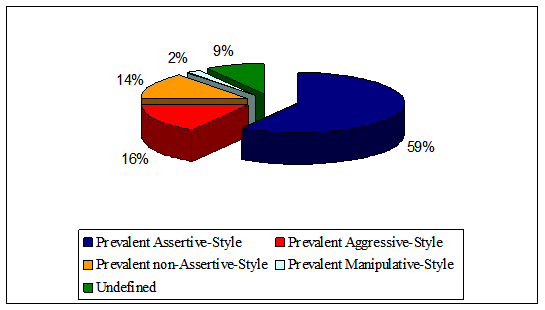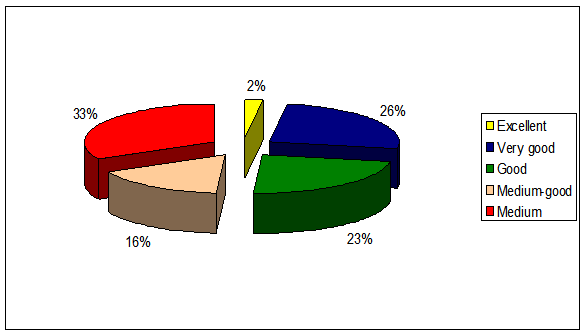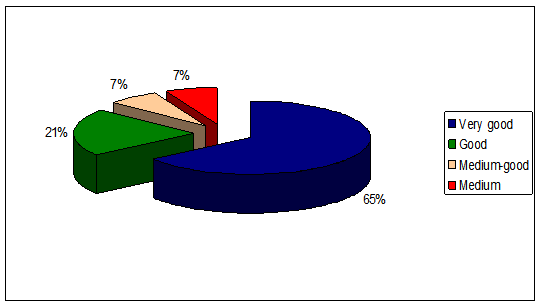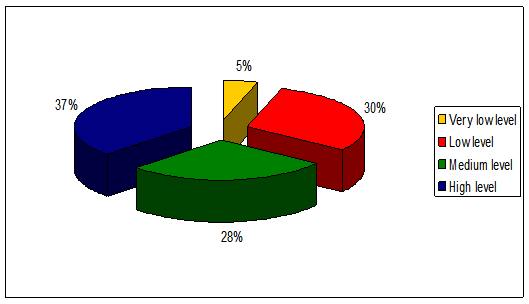Determinative Psychological Factors Of School Performance – Impact Upon Kinetotherapist Professional Profile
Abstract
This study aims at identifying some psychological factors that impact school performance and closely relate to the professional profile of a kinetotherapist. Forty-three second-year Master students in Motor and somato-functional rehabilitation and re-education at the UNEFS Faculty of kinetotherapy formed the research group. Research tools: Communication style self-assessment questionnaire, Prague distributive attention test, Concentration and mobility of attention (CMA) test, Categorial visual memory test, CP5F test and Self-efficacy scale. Concerning the communication skills, descriptive statistics emphasises that the highest average score is recorded for the assertive style, followed by aggressive, manipulative and non-assertive styles, which is beneficial for the therapists’ professional profile. The group average scores for distributive attention, as well as for concentration and mobility of attention, had a significance value related to Good rating, according to technical references. The Big Five personality test revealed T-scores within the population average for all factors, with reduced differences between them, their hierarchy being: conscientiousness, autonomy, agreeableness/kindness, extraversion and emotional stability. As for the Self-efficacy scale, Master students had scores corresponding to third-class medium level, which might correlate with acknowledging their limits and a desire to improve their knowledge on a regular basis. The statistical correlations between psychological factors and school performance substantiate that conscientiousness, visual memory, distributive attention and autonomy have the highest Pearson coefficients related to the variable First-semester average grades.
Keywords: Psychological factorsschool gradeskinetotherapy Master students
Introduction
In the area of therapy, there is a great concern for delivering innovative evidence-based treatments, approaches, complex interdisciplinary strategies, while assessing the profile characteristics of the therapist has been mostly overlooked. Thus, we can notice a certain gap in terms of research between the quality of therapy and the therapist’s competences to deliver that therapy.
This study aims at identifying some psychological factors which impact school performance and closely relate to the professional profile of a kinetotherapist.
The topic is part of the continuous efforts of UNEFS Bucharest to train professionals at high standards, both as specific knowledge and skills and developing personality traits, cognitive abilities or communication abilities. Given the dual preventive and rehabilitation approaches, the social role of kinetotherapy is constantly strengthening, especially in advanced countries, where it is part of the standard of care in various pathologies (Herschell, Kolko, Baumann, & Davis, 2010). In the US, for example, due to an increase in the aging population, there is a growing demand for this type of practitioners, with an incredible 25% raise in the number of jobs between 2016 and 2026. The educational level/professional training required to become a physical therapist is at least the Bachelor’s degree (held by 8% of practitioners), Master’s degree (39%), Doctor’s degree (37%) or other types of degrees (16%). Usually, due to the complexity of tasks that a therapist fulfils on a regular basis, most of the employers administer two tests for their job candidates: the first assessing the ability to think, learn and solve problems, and the second evaluating the personality traits required during interaction with patients.
Problem Statement
Providing top-notch services in kinetotherapy requires certain core skills and common denominators, as recent references acknowledge (Stolorow, 2007, p. 10): non-pathologising, empowering, collaborative, focus, self, relationship and depth. Empathy, social and communication skills, critical thinking, listening skills and management are also essential ingredients for acquiring high professional standards. Basically, they all embed intellectual, ethical, physical and emotional capabilities in a balanced blend. According to the American Physical Therapy Association (2009), the minimum required skills of physical therapist graduates at entry level include cognitive functions, affective and communication functions and psychomotor functions/ skills. Mathews (1989), as well as O’Shea and Peacock (1984), assert that kinetotherapists and occupational therapists are expected to fulfil different roles, which have not always been associated with the traditional professional role: an advocate for the patient; an activist on behalf of the public and the profession; a marketer for his/her specific services; a representative to community organisations; a researcher and educator; a continuing learner; a contributor to new knowledge. In connection with these broad trends, we were interested in assessing some of the core abilities required within kinetotherapy activities, as follows: identifying the communication styles used by the future professionals in kinetotherapy; evaluating the level of certain psychological functions – distributive attention, concentration and mobility of attention, categorial visual memory; assessing the Big Five personality factors described further on; evaluating the self-efficacy of our future graduates; identifying possible correlations between the above-mentioned psychological factors and academic performance, based on two indicators.
Research Questions
Our investigative approach emerges from two hypotheses:
H1: We assume that certain psychological profile characteristics of the kinetotherapy Master students are different from the average scores of the general population.
H2: There are significant statistical correlations between psychological profile characteristics and academic performance, which might indicate a better chance to perform in the future profession.
Purpose of the Study
This study seeks to identify both some psychological profile characteristics of the second-year kinetotherapy Master students and the possible statistical correlations between these factors and school performance, closely related to the professional profile of a kinetotherapist.
Research Methods
Participants
The research group was formed by 43 second-year Master students in Motor and somato-functional rehabilitation and re-education at the UNEFS Faculty of Kinetotherapy. All subjects willingly took part in the testing procedures, being genuinely interested in the topic.
Research tools
Within the study, the following topic-specific research tools were used:
Questionnaire for self-assessment of the four communication styles and ways to react (adapted by Roco, 2001), which comprises 60 items with closed answers, 15 for each communication style: non-assertive, aggressive, manipulative and assertive.
Prague distributive attention test – letters, which evaluates the efficiency to explore a perceptive field including letters and combinations of letters (Perţea, 2004); CMA test for the concentration and mobility of attention.
Categorial visual memory test, assessing the operational visual and verbal memory capacity (MVVC, Perţea, 2004).
Five-factor personality questionnaire (CP5F) (from CAS++, by Cognitrom), evaluating extraversion, emotional stability, conscientiousness, agreeableness /kindness and autonomy (Albu, 2008) by means of 130 items, whose answers are selected from a 5-level response scale.
Self-efficacy scale (Schwarzer & Jerusalem, 1995), made up of 10 items revealing the conviction that one’s actions are success-driven.
Procedure
The testing procedures took place in the UNEFS Psychology Lab during the Psychodiagnosis and psychotherapy seminars and the Counselling and personal development activities organised on a regular basis for the UNEFS students. The testing period was March-April 2018. According to ethical requirements, the subjects were informed about the aim of the study, having the possibility to withdraw at any time, the anonymity and confidentiality of the data being fully ensured. According to the EU DGPR, in this study, no personal data were used. The data were analysed and further discussed during face-to-face and group meetings, in order for the students to grasp their strengths and weak points to draw up a personal development programme.
Briefly, this study was both a way to substantiate the self-knowledge of students through a practical application and a research resource.
Findings
The educational achievement, connected to the profile of a kinetotherapist, relies on the psychological factors described above, which we will analyse in the following.
Table
Within the therapeutic relationship, the communication abilities are essential, being always related to obtaining and transferring valid information about the patient’s health status, getting high levels of satisfaction, reduced frustration and better compliance with the kinetic programme.
Among the communication styles, the most prevalent is the assertive style (10.74-raw score), connected to the capability of expressing one’s thoughts and states in a balanced way generating psychological comfort, a constructive attitude and a better adjustment to social environment. The rest of the hierarchy, as shown in the table, was: aggressive (8.21-raw score), manipulative (8.09-raw score) and non-assertive (7.44-raw score).
The data emerged from the Prague distributive attention test emphasise an average value of 76.46, which is correlated with a Good significance value. This means that the kinetotherapy Master students have a good capability to spread their attention on multiple activities and sources of information (Mitrache & Predoiu, 2016). In the value level references, we identify two more superior levels (Very good and Excellent) and six inferior levels (Medium-good, Medium, Medium-low, Low, Very low and Extremely low).
Another statistically analysed psychological variable was the categorial visual memory, wherein the subjects obtained results corresponding to a Very good significance value. No other superior levels are identified in the references.
The Big Five model test gives information about relevant personality factors, as a synthesis of a wide variety of determinative aspects. The data below are presented in T-scores.
The extraversion component of the investigated group had an average value of 51.39, overlapping the general population mean. Commonly, extrovert therapists are the one preferred by employers, given their orientation towards the external world, including patients and their needs.
The agreeableness component of the investigated group had an average value of 52.58, overlapping the general population mean. Evidently, kind and agreeable therapists are appreciated due to their sympathetic, cooperative and emotional availability, as important “assets” of the professionals.
The conscientiousness component of the investigated group had an average value of 53.18, overlapping the general population mean. This factor is positively related to academic performance, solving professional tasks according to certain standards, discipline and rigour. The subjects had the highest scores in this factor, compared to the other personality factors.
The emotional stability component of the students had an average value of 50.06, also overlapping the general population mean. The work environment is often associated with strain and stress, which require the capability to cope with certain states like fear, guilt, sadness etc.
The autonomy component of the subjects had an average value of 52.67, also overlapping the general population mean. This factor has to do with expressing one’s will freely, conducting the professional life with no interference from outside and making decisions based only on personal convictions.
The evaluated parameters are listed in Table
The Self-efficacy scale component for the investigated group revealed an average value of the raw scores of 31.39, corresponding to a Medium level, given the referential levels. Two superior levels are identified in the references (High and Very high), as well as two inferior ones (Low and Very low).
The academic performance achieved by Master students was calculated based on their average grades after the first year (ten subjects in the two semesters) and their average grades after the first semester of the second year (four subjects). The average for the first year was 8.08, and after the first semester of the second year, 8.35.
In Figure

Figure

The categorial visual memory graph is shown in Figure

Figure

According to hypothesis 2, we calculated the correlations between psychological factors and school performance related to two indicators (first-year grade and second-year first-semester grade), in order to get a clue about the way Master studies have influenced the characteristics of students’ psychological profile in its dynamics.
Statistical matrix emphasised that the most significant correlation (.339 and .351) was recorded between the aggressive communication style and school performance, strengthened in the second year, at p = 0.05. This is explainable because exams are usually connected to an “attack” attittude, which is beneficial in these circumstances. Also, a significant correlation (.301 and .320), at p = 0.05, was recorded between the prevalent assertive style and school performance.
Table
Thus, significant correlations (.428 and .652) were identified between categorial visual memory and school grades at p = 0.01. This is obviously an anticipated result, given the way the learning mechanisms enhance all memory characteristics. Regarding the distributive attention, significant correlations with school performance (.388 at p = 0.05 and .553 at p = 0.01) were identified. Also, in the second year, the concentration and mobility of attention correlated with school grades (- .381) at p = 0.05.
The table above emphasises the correlations between each of the 5 personality factors and academic performance. Among these, conscientiousness (.449 and .683) and autonomy (.485 and .507) have significantly correlated with school grades at p = 0.01, which logically meets the criteria of learning a certain content and gaining more confidence and freedom to make choices. Self-efficacy has significantly correlated with school performance (.350 and .356) at p = 0.05, leading to the assumption that students feel they still have to grow professionally, willing to be more prepared to face specific tasks and situations.
Out of the 26 correlations between psychological factors and school performance, 15 were positive, being statistically significant at p = 0.05 and 0.01. Consequently, H2 was confirmed, indicating a better chance to perform in educational settings.
Conclusion
This descriptive study reveals some of the psychological traits of the future kinetotherapists, in the context of a competitive labour market and initial training requirements.
Generally speaking, the success of kinetotherapists in fulfilling the expected roles requires personality traits, interpersonal skills, certain attitudes that have to be consistent with the demands of this profession.
Our data have emphasised that the majority of kinetotherapy Master students are assertive in their communication conduct, a positive genuine trait that also can be further developed through education and social contacts.
In terms of cognitive abilities – attention and memory, the results of most subjects were above the average of the population, with a particular emphasis on categorial visual memory, whose performance was at the highest level.
All personality traits of most students matched the average values of the population, still with higher values for conscientiousness, autonomy and agreeableness.
Self-efficacy was reported as less consistent, with values from Very low to High, which might indicate a rather modest perception of competence, even if the data matched the average of the population.
Hypothesis 1 has been confirmed in terms of cognitive abilities – distributive attention and its concentration and mobility, categorial visual memory – meaning that the future kinetotherapists have a very good ability to seize and integrate information from multiple sources and retain relevant knowledge. As for assessing self-performance, H1 was invalidated, the results matching the average of the population. Accordingly, a continuous improvement of their professional skills can be envisaged. H1 was not accepted in terms of personality factors, these ones being within the normal distribution of the population.
Our findings confirm the failure of O’Shea and Peacock (1984) to find a personality profile of occupational therapists, which is significantly different from the general profile of the population.
These data are relating to some studies (Rheault & Shafernich-Coulson, 1988) which show that the GPA (grade point average) is not always a good predictor of professional success, suggesting that other variables may also induce the future clinical performance.
In summary, the academic curriculum of the Kinetotherapy Faculty has to further incorporate subjects having both formative and informative values, so that our graduates can fully comply with the professional profile requirements in clinical and educational settings.
Limitations and strengths of the study
Limitations are inherent in this type of study due to the topic we have chosen. If psychological issues are analysed, the measures are somehow flawed, because personality, for example, is hard to completely describe using one specific tool. At the same time, our inner traits are subject to a certain dynamics hard to grasp in a single session trial of assessment.
Another limitation is the number of subjects we investigated, which would have been ideal to be larger and spread on different academic units, so that higher reliability of the data could be achieved.
A possible strength of this study is the idea of drawing up an inventory of the psychological profile traits of kinetotherapy students, so that the curriculum contents could be further applied in order to maximise their specific abilities and positive personality traits.
Acknowledgments
Special thanks to the Kinetotherapy Dean and Secretary Office for providing us the school records for the second-year Master students.
Authors’ contributions: All authors contributed equally to this article and should be considered as main authors.
References
- Albu, M. (2008). Un nou chestionar de personalitate: CP5F. In M. Albu (Coord.), Incursiuni psihologice în cotidian (pp. 7-23), Cluj Napoca: ASCR.
- American Physical Therapy Association. (2009). Minimum required skills of physical therapist graduates at entry-level BOD G11-05-20-449 (Guidelines). Retrieved from http://www.apta.org/uploadedFiles/APTAorg/About_Us/Policies/BOD/Education/MinReqSkillsPTGrad.pdf
- Herschell, A. D., Kolko, D., Baumann, B. L., & Davis, A. C. (2010). The role of therapist training in the implementation of psychosocial treatments: A review and critique with recommendations. Clinical Psychology Review, 30(4), 448-466.
- Mathews, J. (1989). Practice issues in physical therapy. Current patterns and future directions. New Jersey: Slack Inc.
- Mitrache, G., & Predoiu, R. (2016). Psihopedagogie – Curs în tehnologie IFR. Bucureşti: Discobolul.
- O’Shea, B., & Peacock, A. C. (1984). Occupational therapists: Personality and job performance. American Journal of Occupational Therapy, 38(8), 517-521.
- Perţea, Gh. (2004). Teste profesionale de aptitudini şi inteligenţă. Bucureşti: Universitatea Ecologică.
- Rheault, W., & Shafernich-Coulson, I. (1988). Relationship between academic achievement and clinical performance in a physical therapy education program. Physical Therapy, 68(3), 378-380.
- Roco, M. (2001). Creativitate şi inteligenţă emoţională. Iași: Polirom.
- Schwarzer, R., & Jerusalem, M. (1995). Generalized Self-Efficacy scale. In J. Weinman, S. Wright, & M. Johnston, Measures in health psychology: A user’s portfolio. Causal and control beliefs (pp. 35-37). Windsor, UK: NFER-NELSON.
- Stolorow, R. (2007). Trauma and human existence. Routledge.
Copyright information

This work is licensed under a Creative Commons Attribution-NonCommercial-NoDerivatives 4.0 International License.
About this article
Publication Date
16 February 2019
Article Doi
eBook ISBN
978-1-80296-054-9
Publisher
Future Academy
Volume
55
Print ISBN (optional)
-
Edition Number
1st Edition
Pages
1-752
Subjects
Sports, sport science, physical education
Cite this article as:
Mitrache, G., Bota, A., & Predescu, C. (2019). Determinative Psychological Factors Of School Performance – Impact Upon Kinetotherapist Professional Profile. In V. Grigore, M. Stănescu, M. Stoicescu, & L. Popescu (Eds.), Education and Sports Science in the 21st Century, vol 55. European Proceedings of Social and Behavioural Sciences (pp. 112-121). Future Academy. https://doi.org/10.15405/epsbs.2019.02.14
